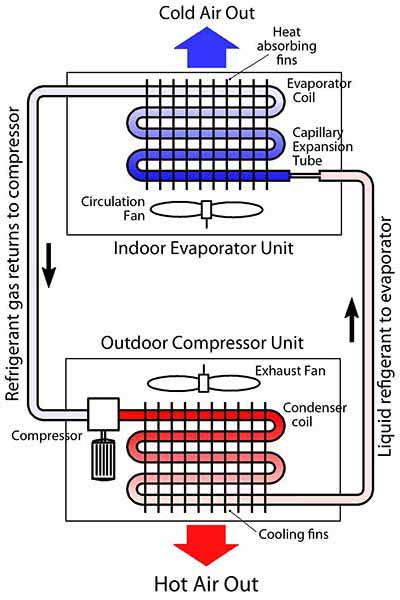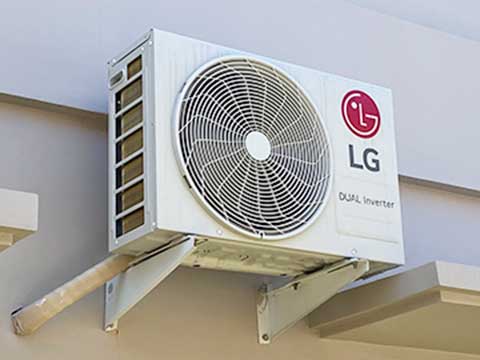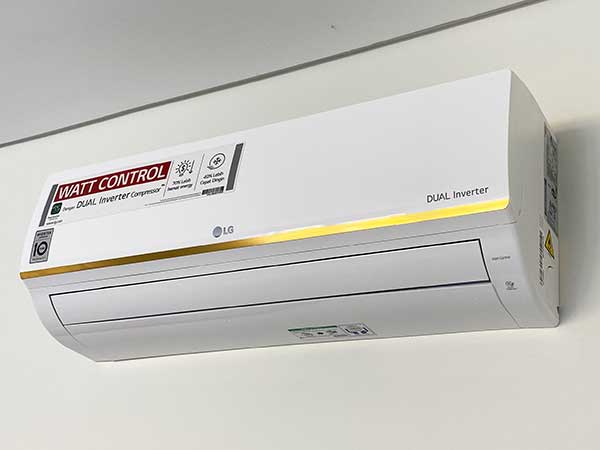How Does An Air Conditioner Work?
The Basic Principle of how an Air Conditioner works
Here we look at the refrigeration cycle that drives an air conditioner through the evaporation and condensation of refrigerant to absorb and then give up heat.
We look at the evaporation unit, the compressor, the cooling coil and fins, the air filter units, water drain and remote control of a typical household split air conditioner.
See also:
- Buying an air conditioner
- Types of air conditioners
- Inverter air conditioners
- Servicing and maintenance of air conditioners
- Air conditioner refrigerants
- Air Conditioner quality and reliability
- How large an air conditioner do you need?
- Air conditioner water heaters give you free hot water
- Climate control, temperature, humidity and dew point
- Building insulation
The Refrigeration Cycle

An air conditioner works by moving heat from inside to outside your house using a process of evaporating and condensing a liquid.
To understand this basic principle let us look at what happens when you boil water. You put the water in a kettle and heat it up. When it gets up to boiling point (100 degrees centigrade) the water doesn't get any hotter, it does, however, carry on absorbing heat but the heat energy doesn't increase the temperature any more, instead it is used to evaporate the water changing it from a liquid into a gas, steam.
It takes a lot of heat to evaporate the water and this is known as the latent (hidden) heat of vaporisation.
Now if we cool the steam down it will lose the heat and condense, changing back into water.
But then there is another important thing about steam. If we compress it we can force it to turn back into water and it will give out heat. If we release the pressure it will boil again (as long as we keep it hot).
Let us see how this principle is applied in an air conditioner.
Refrigerant or freon
First we take a liquid (called a refrigerant) that boils at a much lower temperature than water, it has to be well below the minimum temperature that our air conditioner will run at, let us say -41 degrees centigrade. Obviously at normal room temperature it will have boiled into a gas. (Freon is a tradename used for DuPont refrigerants.) For more information on refrigerants go here.....

Compressor, Condenser or Outdoor Unit
Outside our house, we put the refrigerant gas into a pipe and feed it into a compressor which is mounted inside the outdoor compressor unit of our air conditioner. The compressor is driven by an electric motor and pumps the gas into the condenser pipe up to about 45 psi (pounds per square inch). The compressed gas condenses inside the pipe and changes into a liquid. Heat is forced out of the gas as it changes to a liquid and the condenser pipe will get very hot.
Evaporator or Indoor Unit
We now feed this liquid from the condenser pipe to the inside of our house and into the indoor (evaporator) unit of our air conditioner.
Here it flows through a very narrow "capillary" tube, the tube is so small that it keeps the liquid at high pressure on one side but allows it to slowly run through the tube and into a second wider pipe, the evaporator pipe.

As the liquid flows from the narrow tube into the wider evaporator pipe the pressure is released and the liquid evaporates sucking heat from the pipe which becomes very cold.
(More sophisticated air conditioners use a pressure release valve operated by a temperature sensor instead of a narrow tube.)
This gas is now fed from the evaporator pipe back outside the house and back to the compressor unit ready to be compressed to start the cycle again.
Now we can do some modifications to make our air conditioner work better:
Fans, Cooling Coils and Cooling Fins
The first thing we can do is to put a fan inside the outdoor unit to blow air onto the condenser pipe to blow the heat away into the atmosphere.
The next thing we can do is to bend the condenser pipe inside the outdoor unit to form a coil, this will increase the surface area of the pipe so it will cool down easier.
We can also add cooling fins to the condenser pipe coil (like the fins on a motor cycle engine) this will further increase the fan's ability to cool the pipe.
We can repeat this to the evaporator pipe in the indoor evaporator unit just after the narrow capilary tube adding a fan, coiling the pipe and adding cooling fins to increase the ability to absorb heat from the air in the room. The fan will suck warm air from the room of the house, cool it and blow cold air back into the room.
Water Drain
We now have a small problem. As the air from the room flows over the evaporator pipe it cools and any humidity in the air condenses into water, the air dries out leaving drips of water on the cooling fins. Over a day an air conditioner can draw a lot of moisture from the air in a room. We need to collect this water in the indoor evaporator unit and install a drain pipe to carry it away.
We will now add some additional items to further improve our air conditioner's operation:
Air Filter Unit
We can add an air filter to collect dust from the air as it is sucked into the evaporator unit thereby cleaning the air before it is blown back into the room. These filters are usually a screen of sponge material set across the front of the air intake that can be easily removed and cleaned.
Direction Louvres
By installing louvres on the inside fan unit we can control the direction the cool air blows. These can be made to point in different directions and, many air conditioners, to cycle up and down if required.
Fan Speed Controller
A speed controller on the fan will allow us to set the flow of air to high or low.
Temperature Sensor
Finally we can add a temperature sensor to switch the compressor off once the inside room is cool enough
We now have an air conditioner and while air conditioners come is various configurations they all work using these basic concepts.
Air Conditioner Remote Control
Air conditioners these days are usually controlled by means of a handheld battery operated remote controller. You point the controller at the air conditioner internal unit and press buttons which send out infra red signals.
Inside the internal unit an infra red sensor picks up these signals and feeds them to electronic control circuits and allows you to set the temperature, fan speed, operating mode and the swing of the louvres and also to program on and off timing switches.
See also:
- Buying an air conditioner
- Types of air conditioners
- Inverter air conditioners
- Servicing and maintenance of air conditioners
- Air conditioner refrigerants
- Air Conditioner quality and reliability
- How large an air conditioner do you need?
- Air conditioner water heaters give you free hot water
- Climate control, temperature, humidity and dew point
- Building insulation
Phil Wilson
Copyright © Phil Wilson
This article, or any part of it, cannot be copied or reproduced without permission from the copyright owner.
